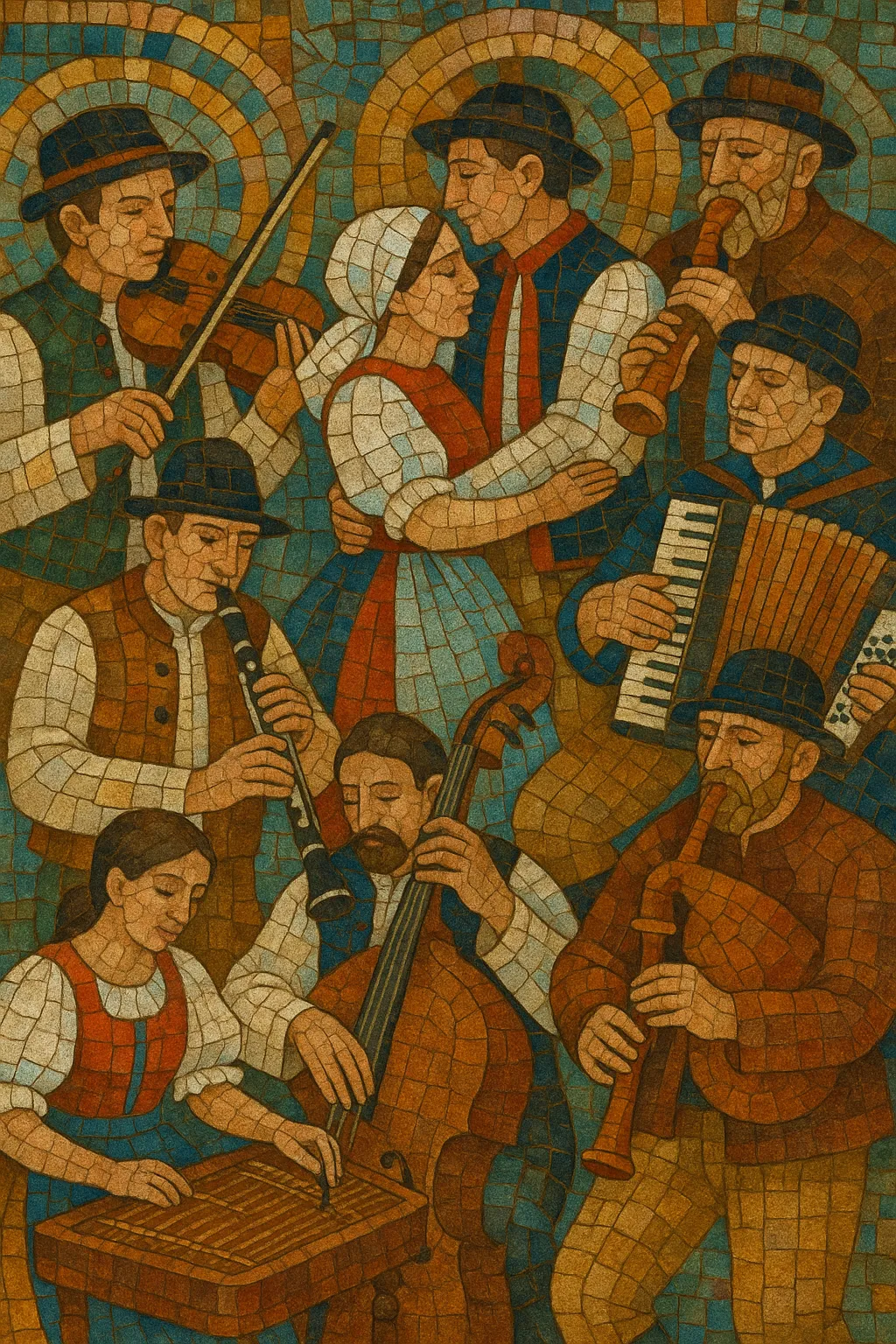
Czech folk music encompasses the traditional song and dance repertories of Bohemia, Moravia, and Czech Silesia, shaped by centuries of village life, seasonal rituals, and local dialects.
It features lively dance rhythms such as polka, furiant, sousedská, skočná, and mazurka, and it is performed by fiddle-led bands and cimbalom ensembles with distinctive regional colors.
Typical instruments include the cimbalom (hammered dulcimer), violins with a lead primáš, viola (kontra), double bass (basa), clarinet, bagpipes (dudy), hurdy-gurdy (ninera), and accordion, often supporting robust group singing.
Melodies lean on major and minor modes with modal flavors (Dorian, Mixolydian), heterophonic textures, and ornamented fiddling, while lyrics address love, work, nature, recruiting (e.g., verbuňk), and festive customs such as Christmas carols (koledy).
Czech folk music grew from the oral traditions of rural communities in Bohemia, Moravia, and Czech Silesia, where songs marked the calendar year, life-cycle events, and communal dances. Bohemian regions favored bagpipes (dudy), hurdy-gurdy (ninera), and small string/woodwind bands, while Moravia cultivated cimbalom-led ensembles (cimbálová muzika) with rich vocal harmonies and ornamented fiddling.
During the early-to-mid 19th century, the Czech National Revival spurred the systematic collection and publication of folk songs and dances. Village repertories and ballroom fashions intertwined, and the polka—emerging from Bohemia—spread internationally. Collectors and composers drew on folk sources to assert linguistic and cultural identity within the Habsburg context.
In the interwar and socialist eras, state and civic institutions supported folk culture through festivals, folkloric troupes, and radio orchestras (notably the Brno Radio Orchestra of Folk Instruments, BROLN). Arranged versions standardized performance practices, while local bands kept regional styles alive. Cross-border exchange with Slovak, Polish, German/Austrian, Hungarian, and Romani traditions remained strong.
After 1989, independent labels, festivals (e.g., Strážnice), and conservatories invigorated the scene. Artists blended tradition with contemporary forms—folk-rock, classical, and experimental—bringing Czech repertoires to world-music stages. Today, village ensembles, professional cimbalom bands, and genre-crossing artists coexist, sustaining both regional authenticity and modern creativity.
Use a cimbalom-led ensemble (cimbálová muzika) with violins (a lead primáš and supporting fiddle), viola/kontra for inner harmonies, and double bass (basa) for a grounded drone and rhythmic pulse. Add clarinet for lyrical lines, accordion for chordal support, and regional colors such as bagpipes (dudy) or hurdy-gurdy (ninera).
Write danceable patterns in 2/4 (polka, skočná) and 3/4 (sousedská, waltz), and experiment with the furiant’s hemiola (2 vs. 3 accent shifts) to create propulsion. For verbuňk, begin with freer, declamatory singing that accelerates into a brisk dance.
Compose strophic, singable melodies with narrow-to-moderate range, using major/minor with modal inflections (Dorian, Mixolydian). Employ heterophony—multiple instruments ornamenting the same tune—and harmonize voices in parallel thirds and sixths. Keep harmonic language clear and folk-like (I–IV–V), occasionally sustaining drones in the bass.
Favor robust, communal singing with call-and-response refrains. Write texts in Czech (or regional dialects) about love, village life, seasons, recruitment, and festive rituals (e.g., koledy). Include refrains that invite audience participation.
Let the primáš introduce the tune, with cimbalom providing arpeggiated accompaniment and percussive fills. Use fiddle ornamentation (grace notes, slides), clarinet countermelodies, and rhythmic bass patterns that accent dance steps. Keep tempos lively yet flexible to follow dancers’ phrasing.

